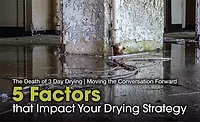The Death of 3 Day Drying (Continued): Air Mover Explanation & Calculations
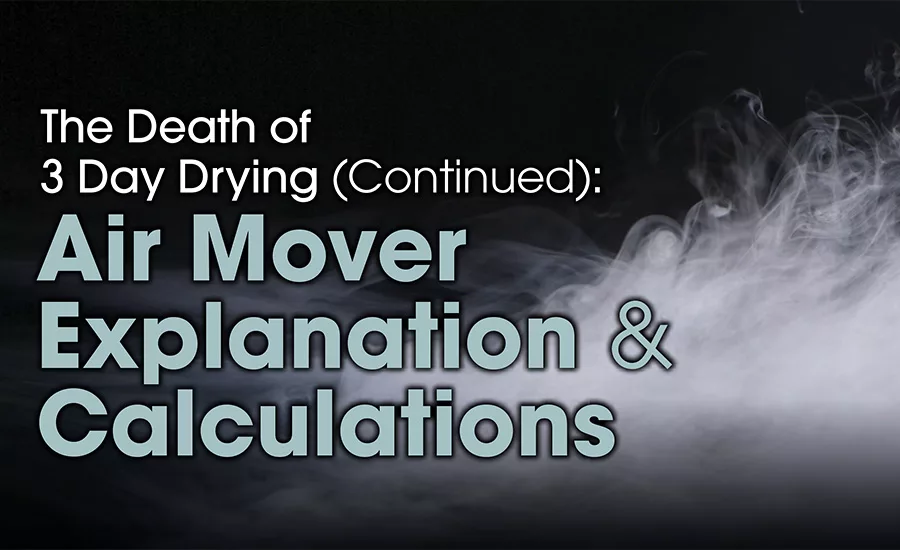
This is the latest in a series of articles on the three-day drying myth, authored by Kris Rzesnoski. Want to learn more about debunking this myth? Click here!
We are now digging into equipment sizing and understanding the ANSI/IICRC S500, Edition 4, 2015 (S500) to improve drying performance and are starting with air mover calculations and getting the job properly sized.
Before you can jump into the calculation, you have to understand a little bit about the IICRC standard and how to read them. Just because words are written in the standard does not mean that they are absolutely to be followed.
Understanding Shall, Should, and Recommended
The following terms located in all the ANSI/IICRC Standards are critical for your to understand before you can apply the standard to your work. The meaning of these are by all intents and purposes to drive clarity and put weight behind the sentences and paragraphs you are reading. They will provide guidance on the importance it should play to the restorer.
SHALL:
“when the term shall is used in this document, it means that the practice or procedure is mandatory due to natural law or regulatory requirement, including occupational, public health or other relevant laws, rules or regulations, and is therefore a component of the accepted “standard of care” to be followed.”
To put this into everyday terms, following the rules and regulations is part of the standard and when there is a conflict between doing work or following the laws, the laws will trump the work. Many of the laws that impact the restorer are health and safety related, regulations around applications of products, regulations of hazardous/regulated materials, and labor laws.
SHOULD:
“When the term should is used in this document, it means that the practice or procedure is a component of the accepted “standard of care” to be followed, while not mandatory by regulatory requirements.”
Deviations from the sentences and paragraphs using “Should” are intended to be intentional and deliberate. Creating company rules that conflict with the standard of care are not acceptable and the restorer should recognize the liability it poses to them. Deviations from the standard of care can be made by the restorer based on their judgement, but ultimately the client must be informed of the deviation and accept it. Failure to follow the standard of care places the restorer at risk of increased liability and would make it hard to defend their actions if reviewed by a qualified reviewer.
RECOMMENDED:
“When the term recommend(ed) is used in this document, it means that the practice or procedure is advised or suggested, but is not a component of the accepted “standard of care” to be followed.”
This last section is where many arguments come from within the standard. A recommended action that may be attempted to be enforced or applied to a job and interpreted to the same weight as a “should”. It is at the discretion of the restorer to follow the recommend(ed) direction, but does not necessarily create a conflict on the job.
To see the full section on “Important Definitions”, go to the front of any standard and you will find it in the first 15 pages.
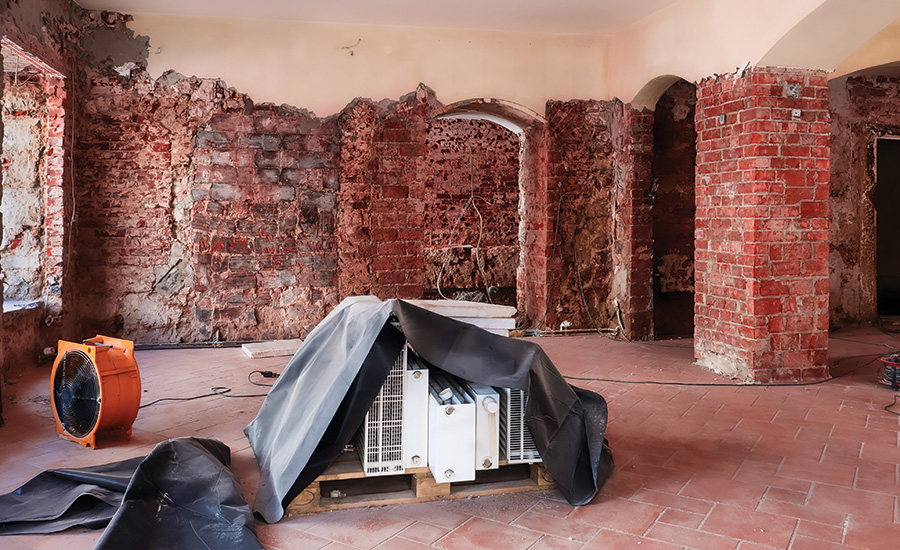
Understanding the Equipment Calculation
When you explore the equipment calculations in the ANSI/IICRC S500, Edition 4, 2015 your journey will not find the following information in the standard:
- The exact number of units required for the life of the job
- The performance impact of those units on the job
- The time it will take to do the job (2 days, 3 days, 4 days etc)
- How each material will respond to the equipment
The standard also does not mean that a competent restorer will take as long as they want to dry a project, but it does mean that various factors and variables will impact the ability to dry materials. The standard provides you with a good starting point, but that is all that it is…. a starting point.
In section 13.5.6.1 Controlling Airflow is where you will find information on airmover calculations.
I am going to break down this section because it is important to understand what “Should” happen and what is “Recommended”.
Airmovers should be set up to provide continuous airflow across all affected wet surfaces (e.g., floors, walls, ceilings, framing). In order to achieve this, it is recommended that restorers position airmovers to:
- Ensure adequate circulation of air throughout the drying environment,
- Direct airflow across the affected open areas of the room,
- Account for obstructions (e.g., furniture, fixtures, equipment and structural components), if their presence prevents sensible airflow across the affected surfaces,
- Deliver air along the lower portion of the affected wet wall and edge of the floor
- Point in the same direction with the outlet almost touching the wall, and
- Deliver air at an angle (e.g, 5-450)along the entire length of affected walls”.
The first paragraph is stating that the restorer should provide continuous airflow across the affected wet surfaces. This is something that the restorer is expected to do to follow the standard of care. Regardless of anything else that happens, calculations or otherwise, the restorer’s duty is simple.
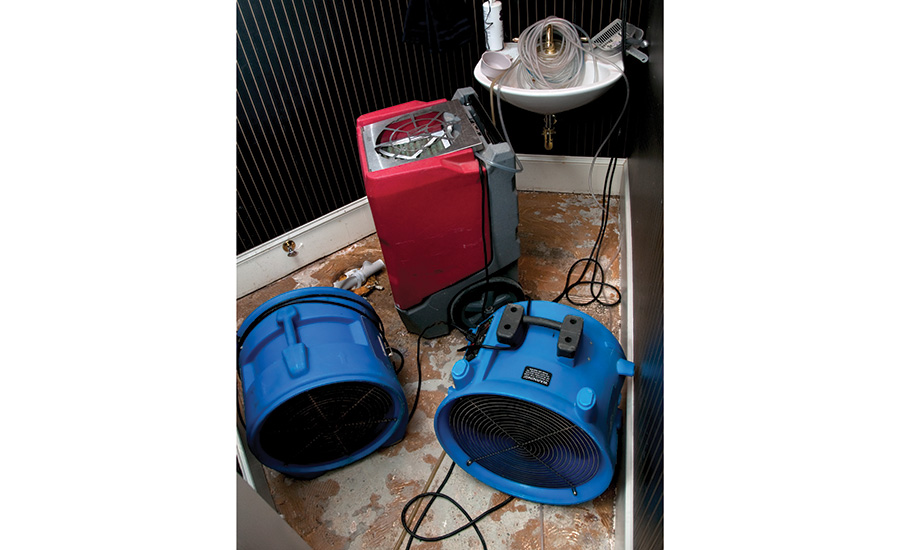
“Provide continuous airflow across affected wet surfaces.”
The standard provides additional context of how a restorer can achieve this and “recommends” the additional items in bullet points. The recommended are not part of the standard of care and therefore they are guidance that might help you achieve continuous airflow across affected surfaces. You may have a time when you are required to have the airmovers angled at 900 to the wall. They may be equipped with a snout adapter to push air into the wall cavity or under hardwood floors. You may choose to angle that air mover that way for a specific purpose. These will change depending on that application based on the restorer’s professional judgement.
In the insurance industry, they are specialists at looking at wordings and making sure the words are carefully selected. Just like an adjuster reading coverage where the words matter and can dramatically impact the outcome of whether a claim is covered or not covered by the policy, the standard uses specific language to guide the actions of the restorer.
Upon initiating the restorative drying effort, restorers should install one airmover in each affected room. In addition, add one airmover:
- For every 50-70 SF of affected wet floor in each room (to address floors and lower wall surfaces up to approximately 2 feet)
- For every 100-150 SF of affected wet ceiling and wall areas above approximately 2 feet, and
- For each wall inset or offset greater than 18 inches.
Feel a little more empowered? The should and recommended even impact your equipment calculations. The above noted calculations are “shoulds”, meaning they are part of the standard of care. Remember one of the bullet points in the last section. It is recommended that you consider adding additional air movers for obstructions, meaning the restorer’s discretion is required. If this is in question by a reviewer, the ultimate determination for if the action was fair and reasonable is:
“Did the action provide continuous airflow across the affected wet surfaces?”
I am not going to explain the entire section (purchase a copy of the S500 to read more) and clarify the details of each paragraph, but I am pointing out that you need to be familiar with the standard and justify your actions. Was there a shall, should or recommended in the sentence you are referring to? If the client is pushing back against your decision to place additional equipment, can you defend your actions using the S500 and justify meeting your objective?
The number of airmovers is less important than the overall objective to provide continuous air movement across the wet surfaces. It stresses the point that continuous air movement is the key to decisions being made.
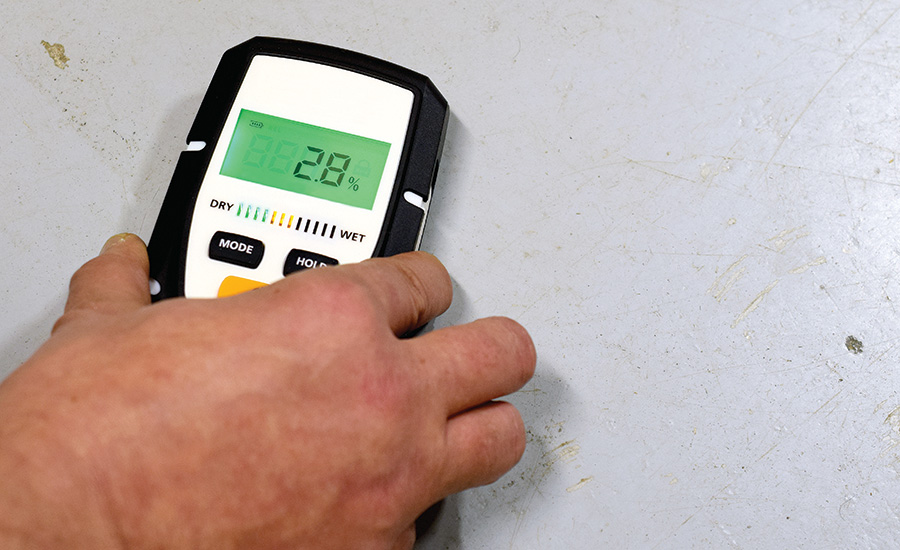
How Often Do You Perform An Inspection?
The last paragraph of this section is critical to understand why and how you inspect a job.
“After the initial installation, restorers should inspect and make appropriate adjustments (e.g., increase, decrease, reposition) to the number, type, and placement of airmovers based on materials’ moisture readings. The first of these inspections to monitor and make adjustments should be performed no later than the day following the initiation of restorative drying. The frequency of subsequent monitoring should be daily until drying goals have been met, but may be adjusted by the agreed scope of work, potential for secondary damage, job site accessibility, or by agreement between the materially interested parties.”
The risk that restorers run into is that the air movers may increase the humidity levels in a structure early and if uncontrolled will allow conditions to be prime for mold growth and other secondary damages. The importance of managing that humidity on the first day and controlling the environment day after day to ensure that the optimum drying conditions are working on the job cannot be overstated. Cycle time for both the restorer and the insurance company are shortened when the restorer puts an emphasis on the proper equipment setup each day and makes the proper adjustments until the job is completed.
Conclusion
If you have been drying structures long enough, you know that air flow is one ingredient in the recipe for properly drying a structure. Air mover counts, velocity of the airmovers, and even other air movement equipment for moving air in and behind the walls, under floors, and
in various other cavities is critical for a successful job.
The restoration industry should be cautioned that there are many program rules that are being applied to the restoration industry by outside parties that prevent the restorer from inspecting the job daily as a rule. These policies conflict the standard of care and deviations from the standard should be made on a job by job basis not as the rule. The fact a substantial limitation is being placed on the restorer takes us back to 11.2 Limitations of the S500 and restorers should be cautioned that:
“Only the owner or owner’s agent, not the restorer or others, can impose limitations on the performance of a project.”
In the next article we are going to look at the ANSI/IICRC S500 Version 4, 2015 Standard and discuss dehumidification calculations and placement of these units you might be in for a bit of a surprise.
Looking for a reprint of this article?
From high-res PDFs to custom plaques, order your copy today!




